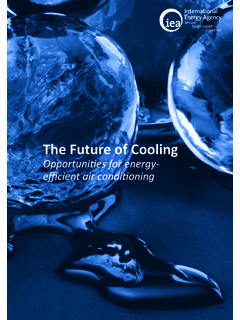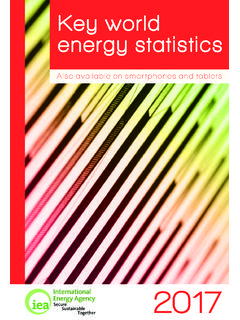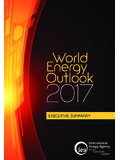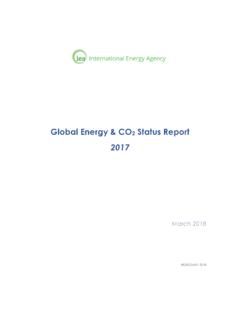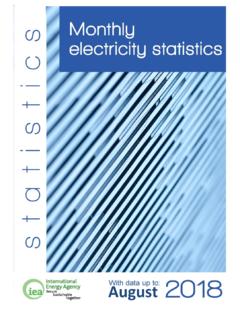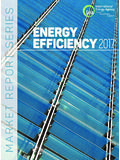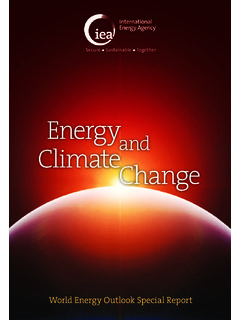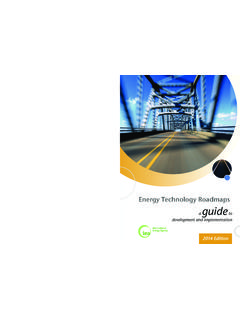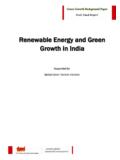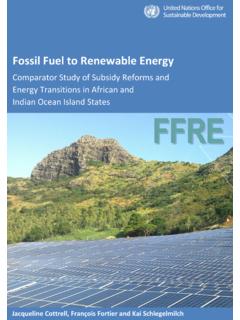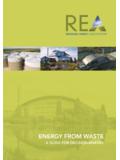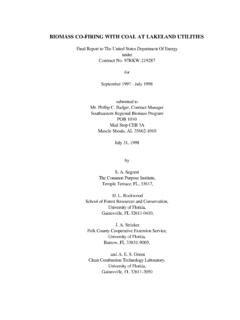Transcription of Renewable Energy for Industry - International …
1 Renewable Energy for Industry From green Energy to green materials and fuels C dric Philibert The views expressed in this paper do not necessarily reflect the views or policy of the International Energy Agency (IEA) Secretariat or of its individual member countries. The paper does not constitute advice on any specific issue or situation. The IEA makes no representation or warranty, express or implied, in respect of the paper's content (including its completeness or accuracy) and shall not be responsible for any use of, or reliance on, the paper. Comments are welcome, directed to International Energy AGENCY. The International Energy Agency (IEA), an autonomous agency, was established in November 1974. Its primary mandate was and is two-fold: to promote Energy security amongst its member countries through collective response to physical disruptions in oil supply, and provide authoritative research and analysis on ways to ensure reliable, affordable and clean Energy for its 29 member countries and beyond.
2 The IEA carries out a comprehensive programme of Energy co-operation among its member countries, each of which is obliged to hold oil stocks equivalent to 90 days of its net imports. The Agency's aims include the following objectives: n Secure member countries' access to reliable and ample supplies of all forms of Energy ; in particular, through maintaining effective emergency response capabilities in case of oil supply disruptions. n Promote sustainable Energy policies that spur economic growth and environmental protection in a global context particularly in terms of reducing greenhouse-gas emissions that contribute to climate change. n Improve transparency of International markets through collection and analysis of Energy data. n Support global collaboration on Energy technology to secure future Energy supplies and mitigate their environmental impact, including through improved Energy efficiency and development and deployment of low-carbon technologies.
3 N Find solutions to global Energy challenges through engagement and dialogue with non-member countries, Industry , International organisations and other stakeholders. IEA member countries: Australia Austria Belgium Canada Czech Republic Denmark Estonia Finland France Germany Greece Hungary Ireland Italy Japan Korea Luxembourg Netherlands New Zealand Norway Poland Portugal Slovak Republic OECD/IEA, 2017. Spain International Energy Agency Sweden 9 rue de la F d ration 75739 Paris Cedex 15, France Switzerland Turkey United Kingdom Please note that this publication United States is subject to specific restrictions that limit its use and distribution. The European Commission The terms and conditions are also participates in available online at the work of the IEA. OECD/IEA 2017 Renewable Energy for Industry From green Energy to green materials and fuels Acknowledgements This publication was written by C dric Philibert of the Renewable Energy Division of the International Energy Agency (IEA), under the supervision of Paolo Frankl, Head of the Division, and Keisuke Sadamori, Director of Energy Markets and Security.
4 It has benefitted from inputs and comments by many IEA colleagues, in particular Heymi Bahar, Simon Page | 1. Bennet, Emanuele Bianco, St phanie Bouckaert, Adam Brown, Ute Collier, Karolina Daszkiewicz, John Dulac, Araceli Fernandez, Tim Gould, Timur G l, Pharoah Lefeuvre, Juho Lipponen, Eric Masanet, Simon Mueller, Joe Ritchie, Cecilia Tam, Laszlo Varro, Louise Vickery, Michael Waldron and Kira West. It has also been improved by the innumerable comments and contributions of participants at a series of specific workshops held in Paris (May 2015), in Beijing (April 2016) as part of the Global Energy Interconnection conference of the State Grid Corporation of China (SGCC), and in Washington (November 2016), co-organised and hosted by the Electric Power Research Institute (EPRI).
5 Furthermore, numerous organisations and companies have been part of this effort, providing valuable information and input: AEE/Intec, the Australian Renewable Energy Agency, BASF, Chalmers University of Technology, China's National Center for Climate Change, the China National Renewable Energy Center, Confederation Paper Industries, lectricit de France (EDF), Energy Pool, Engie, EPRI, Eurelectric, the European Copper Institute, Fraunhofer ISE, the German Aerospace Center (DLR), GlassPoint, the IEA. Bioenergy Technology Collaboration Programme (TCP), the IEA Hydrogen TCP, the IEA. Renewable Energy Technology Deployment (RETD) TCP, the IEA Solar Heating and Cooling (SHC) TCP, the IEA SolarPACES TCP, the Institut du D veloppement Durable International /Low Carbon Technology Platform initiative, the International Finance Corporation, the International Renewable Energy Agency (IRENA), Italcementi, the National Renewable Energy Laboratory, the National Rural Electric Cooperative, the New Energy and Industrial Technology Development Organization (NEDO), Nel Hydrogen, Pacific Northwest National Laboratories, the Roquette Group, the RWE Group, Schneider Electric, SGCC, SolarReserve, Southern Company, the Swedish Energy Agency, Tsinghua University, TU Delft, the United States Department of Energy (DOE)
6 , the World Resource Institute, and Yara International . Other individuals who provided comments and contributions during the writing of this report include Ren Ba ares-Alc ntara, Richard Baron, Jean-Pierre Birat, Tobias Bischof- Niemz, Denis Bonnelle, Christian Breyer, Trevor Brown, Stephen Crolius, Bill David, B rbel Epp, M rten G rnerup, Georgina Grenon, Ilka Hannula, Caroline Hillegeer, Nigel Holmes, Mahdi Fasihi, Thierry Lepercq, Stuart Licht, Keith Lovegrove, Philippe Malbranche, Colin McMilan, Xavier Moreau, Fokko Mulder, Gus Nathan, Richard Nayak-Luke, Michael Paunescu, Kristian Petrick, Julia Reinaud, Catharina Ringborg, Gunnar Sanner, Christian Sattler, Rajendra Shende, Bj rn Simonsen, Stephan Singer, Rob Stevens, Guy-C dric Werlings, Ian Wilkinson and Tomas Wyns.
7 The draft was edited by Kristine Douaud, with help from Michelle Adonis and Ute Collier. Thanks also to Therese Walsh, Astrid Dumond and Katie Russell in the IEA. Communication and Information Office for their help in co-ordinating editing and producing the final report. Financial support from the French government, through the French Environment and Energy Management Agency (ADEME), and from the German government made this work possible and is gratefully acknowledged. Renewable Energy for Industry OECD/IEA 2017. From green Energy to green materials and fuels Table of contents Acknowledgements .. 1. Table of contents .. 2. Page | 2. Executive summary .. 4. Emergence of new options for increasing the uptake of renewables in Industry .. 4. Policy and market considerations for accelerating the uptake of renewables in Industry .
8 7. Introduction .. 9. The need for near-zero net emission levels .. 10. The growing role of industrial emissions .. 11. The need for innovation .. 12. Chapter 1. Current Renewable technologies .. 15. A. Bioenergy .. 16. B. Solar heat .. 17. C. Renewable 19. Electrification .. 19. Procurement .. 21. Chapter 2. Emerging technologies and options .. 23. A. Extractive industries .. 23. Oil and gas extraction .. 23. Refining .. 24. Minerals .. 25. B. Chemicals .. 27. Hydrogen .. 28. Ammonia .. 30. Methanol .. 35. High-value chemicals .. 38. C. Iron and 39. D. Cement .. 42. Chapter 3. Renewable carbon-neutral fuels for industries .. 45. Chapter 4. Policy options .. 54. A. Lessons learned .. 54. B. International 56. C. 58. Acronyms and abbreviations .. 60. Units of measure.
9 62. 63. OECD/IEA 2017 Renewable Energy for Industry From green Energy to green materials and fuels List of figures Figure ES-1. Cost of ammonia at various electricity prices and electrolyser load 5. Figure ES-2. Concept scheme of direct and indirect electrification of Industry and other end uses of renewables .. 6. Figure 1. Indicative global Energy sector CO2 emission trajectories for different Page | 3. decarbonisation pathways .. 10. Figure 2. Remaining CO2 emissions in the 2DS .. 11. Figure 3. Share and breakdown of heat demand in Industry .. 12. Figure 4. Country/regional shares of global biomass use in Industry .. 16. Figure 5. Cost of solar heat in relation to temperature and size of installation .. 18. Figure 6. Power generation capacity additions to directly serve commercial, industrial and public consumers.
10 21. Figure 7. Cost of hydrogen from electrolysis for different electricity costs and load factors .. 28. Figure 8. Hybrid solar and wind full load hours adjusted by critical overlap in 2005 .. 29. Figure 9. Costs of ammonia from SMR for various plant capacities .. 31. Figure 10. Indicative breakdowns of a large-scale all-electric ammonia plant's power needs .. 31. Figure 11. Electrolyser relative size, curtailment and load factors: the case of South Africa .. 33. Figure 12. Cost of ammonia at various electricity prices and electrolyser load factors .. 33. Figure 13. Concept scheme of Renewable production of ammonia for a variety of uses .. 34. Figure 14. Concept scheme of carbon-neutral, Renewable methanol production .. 37. Figure 15. Iron- and steelmaking methods.
